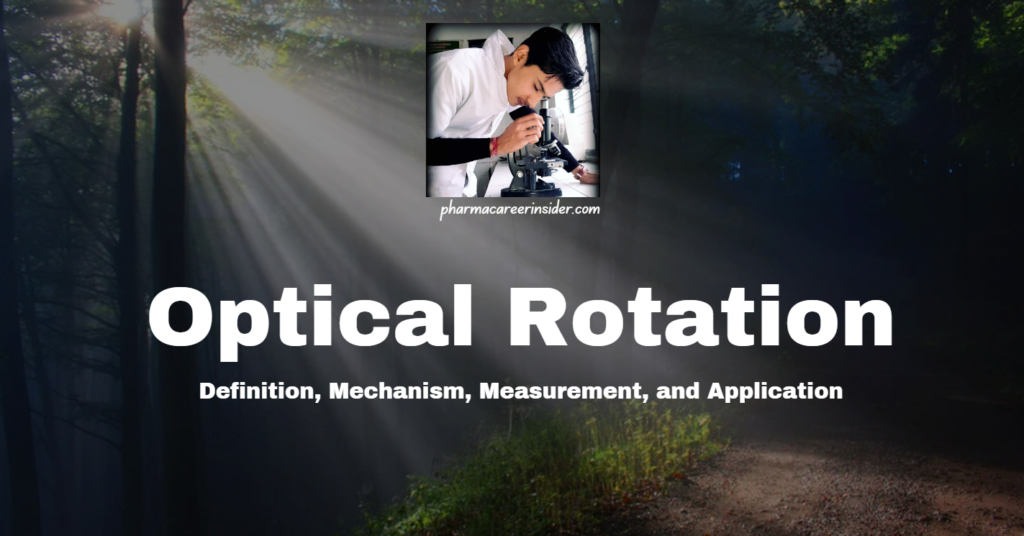Definition
Optical rotation, also known as optical activity, is a phenomenon where a substance rotates the plane of polarized light passing through it. This property is commonly observed in chiral compounds, which lack a plane of symmetry and exist in two mirror-image forms called enantiomers.
Chirality and Enantiomers
1. Chirality:
– Chirality is a property of molecules that possess a non-superimposable mirror image, much like the left and right hands.
– Chiral compounds are optically active, exhibiting optical rotation.
2. Enantiomers:
– Enantiomers are a pair of chiral molecules that are mirror images but not superimposable.
– They rotate polarized light in opposite directions, resulting in optical activity.
Mechanism of Optical Rotation
1. Interaction with Polarized Light:
– When plane-polarized light passes through a chiral substance, the interaction with asymmetrically arranged molecules causes a rotation of the plane of polarization.
2. Dextrorotatory and Levorotatory:
– If the rotation is clockwise (to the right), it is termed dextrorotatory (designated as \( + \)).
– If the rotation is counterclockwise (to the left), it is levorotatory (designated as \( – \)).
Measurement
1. Polarimeter:
– A polarimeter is the instrument used to measure optical rotation.
– It consists of a light source, a polarizer to create plane-polarized light, a sample tube, and an analyzer to detect the rotated plane of light.
2. Specific Rotation (α):
– The specific rotation is a standardized measure of optical rotation and is calculated using the formula:
[ α] = α/cl
where:
(α) is the observed optical rotation in degrees,
(c) is the concentration of the solution in g/mL,
(l) is the path length of the sample tube in decimeters.
Factors Influencing Optical Rotation
1. Nature of the Substance:
– Chirality and the presence of chiral centers determine optical activity.
2. Concentration:
– Optical rotation is directly proportional to the concentration of the chiral substance. Higher concentrations generally lead to larger rotations.
3. Path Length:
– The length of the path through which the light travels in the sample tube influences the observed rotation.
4. Wavelength of Light:
– The wavelength of light used in the measurement can impact the observed optical rotation.
Applications
1. Chirality Determination:
– Optical rotation is crucial for determining the chirality of a compound and establishing its enantiomeric purity.
2. Pharmaceutical Industry:
– Pharmaceutical companies use optical rotation to assess the purity and quality of chiral drug substances.
3. Food and Flavor Industry:
– Essential oils, flavor compounds, and certain food additives often exhibit optical activity. Measurement of optical rotation is employed for quality control in the food industry.
4. Chemical Synthesis:
– In the synthesis of chiral compounds, optical rotation is a valuable tool to monitor reactions and assess the formation of desired enantiomers.
5. Biological Studies:
– Optical rotation is used in the study of biomolecules, including sugars and amino acids, which often exhibit optical activity due to their chiral nature.
Challenges and Considerations
1. Solvent Effects:
– The choice of solvent can impact optical rotation, and measurements are often conducted in standardized conditions.
2. Temperature:
– Changes in temperature can influence the observed optical rotation.
3. Concentration Dependence:
– Care must be taken to ensure that the concentration of the sample is accurately measured.
Optical rotation is a powerful tool for characterizing chiral compounds, playing a vital role in various industries and scientific research. Its applications in determining enantiomeric purity and understanding the chiral nature of molecules make it an essential technique in chemistry, pharmaceuticals, and other fields where the stereochemistry of molecules is crucial.



 Conference Date: 29th March 2025 […]
Conference Date: 29th March 2025 […]